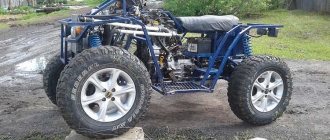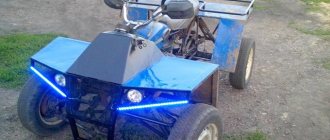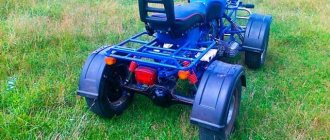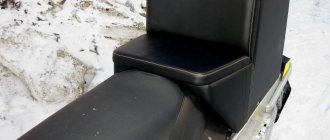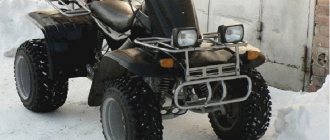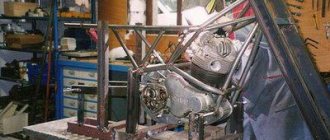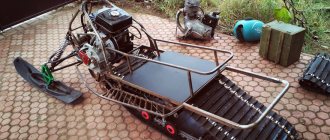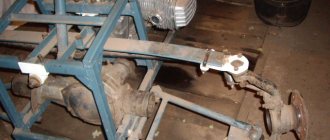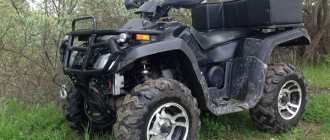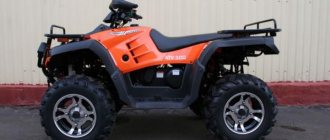ATV built on the basis of the Dnepr MT-10 motorcycle: photo and description.
This homemade ATV was made at home; a Dnepr MT-10 heavy-duty motorcycle was used as a donor. The process of converting a motorcycle into an ATV is shown in these photos.
The frame from MT was modified, additional mounts were welded for the front and rear suspensions, homemade suspension arms, shock absorbers from a motorcycle, and a rear axle from a VAZ-2101 (shortened).
VAZ wheels.
Rear suspension.
- Front suspension.
- Steering.
- Front and rear trunk.
- The front bumper is made from motorcycle bars.
- This is what the ATV looks like after painting.
Source: https://avto-samodelki.ru/samodelnyj-kvadrocikl.html
DIY ATV
An ATV from a store is not a pleasure accessible to everyone. Therefore, many craftsmen make quadrics with their own hands. And in this article we will talk about the most interesting of them.
In making an ATV, everything that can be found in the garage and nearby can be useful. Each vehicle made by hand is unique and individual, so it is difficult to talk about drawings and diagrams.
Few people describe in detail the process of building their brainchild, which makes it extremely difficult to find specific information. But there are also exceptions.
How to make an ATV with your own hands
in 2012, the talented designer S. Pletnev shared the drawings and nuances of building his brainchild.
What was used in the design of the vehicle:
- Front and rear wheels from Niva Chevrolet 15 inches
- Engine a-m Oka
- Oka gearbox
- Inter-wheel gearboxes from the rear axles of the VAZ “classic”
- CV joint from a VAZ-2108 car, 12 pcs.
- Fuel tank 20l canister
- Passenger support from the headrest of the Oka
- Clutches from Oka
- Steering wheel from a Ural motorcycle"
- Instrument panel from Oka car
Main technical characteristics of the ATV:
| Weight | 430kg |
| Length | 2300 mm |
| Width | 1250 mm |
| Handlebar/saddle height | 1250 / 900 mm |
| Ground clearance, | 300 mm |
| Wheelbase | 1430 mm |
| Track | 1045 mm |
| Maximum speed | 65 km/h |
ATV drawings:
The transmission is made from AvtoVAZ units with some modifications. For example, to reduce speed and increase torque, a chain drive was used instead of the main pair.
Inter-wheel gearboxes are borrowed from the classics, the axle shafts are removed and replaced with CV joints from the front-wheel drive VAZ. Constant velocity joints are also used in other transmission units.
The suspension is independent on triangular wishbones. Shock absorbers from Oka.
Homemade muffler of 2 sections, insulated with asbestos.
The body kit is made of fiberglass. The creation of such plastic took 10 kg of epoxy resin, 1 kg of plasticizer and the same amount of hardener. 15 meters of fiberglass and 5 meters of glass mat.
The ATV body kit is made of fiberglass. I glued it for the first time, and therefore first studied the recommendations for performing the relevant work. But as it turned out, this process is painstaking, although the result is worth it.
- The bumpers and guardrails are welded from 20mm round pipes.
- Photo of the finished ATV:
- Material based on the article: https://modelist-konstruktor.com/razrabotki/853
ATV from a motorcycle
- This quad is made on the basis of the Ural motorcycle.
- All the details are in the video.
ATV with IZh Jupiter engine. Transfer case from Ant motorcycle.
ATV Cobra MIX
- Generator, forced cooling, lowering gear, electric starter from tens, engine from a Ural motorcycle.
- Video of a homemade ATV in action:
Homemade buggy "Raptor"
Homemade ATV with an Oka engine
Source: https://anarchymotors.ru/article/kvadrotsikl-svoimi-rukami.html
Tools and materials
The set of accessories used is determined by what kind of ATV they are trying to create. Utilitarian models weigh quite a lot, but boast excellent cross-country ability. It is easy to transport several people on such cars. The speed reaches 90 km/h. The stunt machine can accelerate to 137 km/h; Narrow platforms are required.
The main components of the device itself are:
- actuator;
- suspension;
- seat;
- luggage compartment;
- chassis, steering and brake parts.
You also need to take into account the battery, external light, muffler.
To work you will need:
- electric drill;
- angle grinder;
- wrenches;
- jack;
- pliers;
- calipers;
- hammer;
- sharp knife;
- screwdrivers;
- pipe bender
Components from the following types of vehicles are usually taken as a basis:
- motorcycles;
- scooters;
- small cars.
Homemade ATV
A quad bike is actually any four-wheeled vehicle, since in Latin “quadro” means “four”. In the CIS, this name most often means an all-wheel drive all-terrain vehicle, representing a symbiosis of a motorcycle and a car.
From a motorcycle, an ATV has adopted mobility, maneuverability, lightness, and speed, and from a car - excellent cross-country characteristics, power and controllability.
The result is a unique vehicle designed for a variety of purposes.
The domestic market provides only foreign models of ATVs, the cost of which is often exorbitant. At the same time, you can easily find used motorcycles and cars on the secondary transport market at an extremely low price.
For example, the Ural motorcycle is large, bulky, heavy and power-hungry, has an excellent four-stroke engine with reverse gear and costs a penny. For this reason, it is much cheaper and more fun for enthusiasts to create their own designs of these SUVs.
A typical factory ATV - shiny, neatly built, strong and powerful.
Its homemade counterpart, which is slightly inferior in appearance, and even more so in terms of power.
How to make an ATV with your own hands
Before you start assembling, you need to make a detailed list of the units and parts that will be needed to create your own brainchild, develop a work plan and a design drawing.
Engine: the optimal choice
It is logical that first of all it is necessary to find the “heart” of the future “beast” - the power unit. Absolutely anything will do, from a regular walk-behind tractor to a six-liter V12 - there are such precedents. In most cases, motorcycle engines are used - they are economical and small-sized.
To use high gear ratios under normal operating conditions, a Minsk or Ural engine will be sufficient. In summer, the issue of overheating arises, so you should choose air-cooled models. Another good option is Soviet-made boxer engines, the undeniable advantage of which is powerful traction and a completely unpretentious driveline.
Suspensions: rear and front
There are two most common rear suspension solutions for ATVs.
- Gear-cardan system. The design turns out to be as lightweight and simple as possible, but there is no differential, which, in principle, can be sacrificed for the sake of the previously mentioned advantages.
- Using a road bridge. The design turns out to be extremely heavy, and if there is no desire to have an ATV with a car base, it is necessary to shorten the bridge, which is a very non-trivial task. The only advantage worth highlighting is the presence of a differential, which is useful when driving on highways.
There are huge possibilities for front suspension and steering. ATV suspension arms carry significantly less load than automobile ones; accordingly, they can be made independently, using available means. The best option is to create a suspension based on the existing Ural motorcycle.
Frame: drawings and alternatives
The best solution is a durable structure made of pipes or profiles welded together.
Ideally, remove the frame from the donor motorcycle and add the necessary elements - this eliminates a number of problems, but the design may turn out to be unnecessarily complex.
ATV assembly
Having prepared the necessary tools, donor vehicles and freed up time, you can begin to create your own ATV:
- We assemble the frame (frame). We connect the prepared metal beams, according to the drawing, to each other using spot welding. We check the structure and carry out full welding. Alternatively, you can simply remake the frame from the donor motorcycle - it will turn out no worse.
- We install the engine. It can be placed both at the rear and at the front - the main thing is to secure it firmly with bolts to the bottom of the frame.
- We mount the drive and transmission on the rear wheels. The drive does not need to be created independently - it is transferred together with the engine from the donor vehicle and installed on the frame. Again, it is necessary to properly secure the drive and transmission to the frame to prevent play.
- We also install the steering from the motorcycle. Along with the steering wheel, the fuel tank also “migrates” to the ATV. In general, if you imagine the design, it will look like this: 3/4 of the ATV is the same Ural or another motorcycle, 1/4 is a homemade frame and suspension.
- We install wheels from a small-sized vehicle (“Oka” or “ZAZ-968”). The rear wheels can go to the ATV together with the rear axle of the car, or they can be attached as follows: we take ready-made axles with disks, after which we attach a gearbox to the rear one for drive. and we install wheels on the rims, which can even be with low-pressure tires.
- We assemble a single drive with a gearbox on the rear axle and an engine (again, it will be easier if it is completely rearranged from the donor vehicle). We do this as follows: we stretch the chain from the engine to the gearbox and secure it, after which we check the functionality. Ultimately, we fix the entire structure on the frame.
- The front suspension is independent - this is more profitable in terms of time and money, since an all-wheel drive ATV requires significant modification of this unit by a professional turner, welder and electrician, which will take a lot of time. As an option, we purchase ready-made factory components for ATVs.
Step by step instructions
To make an ATV from a walk-behind tractor, you do not need to significantly alter the equipment. The process itself includes the following steps:
- The wheelbase is expanding. Since the disks of the walk-behind tractor are located directly under the walk-behind tractor, they are moved apart. The inserts are turned on a machine, and if there is none, then they simply purchase suitable adapters that serve to expand this base.
- The frame is being installed. It must be strong and reliable. Usually a ready-made motorcycle frame is used, but with certain skills you can weld pipe cuttings together. A significant load will be placed on this part, since it is on it that the engine and all the main components are mounted. The frame is connected to the entire unit using two special pins and a swivel joint.
- Wheels are installed, the size of which varies, depending on the purpose of the motorized device. The first step is to select the disks. It is better to use automobile ones, under low-profile tires, so that the camera fits tightly to them. To maintain integrity and longer service life, it is recommended to place a durable but soft cloth between the disc and the camera.
Instead of tires, you can use tubes from heavy-duty vehicles, which will increase stability and traction area. Their use will also help increase the depreciation of equipment. But they are thin and do not have a margin of safety, so such wheels will be easily damaged by thorns, twigs and sharp objects. One way out that protects tires from damage is to wrap them with a tarpaulin hose and then fix it with instantly hardening glue.
This is how a walk-behind tractor can be easily and simply transformed into a unit that can quickly and maneuverably move across fields, hills, steep ravines and other places where there is no asphalt road surface.
A self-assembled ATV is no worse in functionality and characteristics than factory devices. The main thing is that you know its strengths and weaknesses, and the unit made with love will last a long time and without any problems. You just need to carry out maintenance on time and monitor the condition of all systems.
This is interesting: a snow blower made from a trimmer with your own hands.
You should take into account all the little details, carefully select all the necessary materials and accurately carry out all the work.
In general, having special and simply basic and additional tools available, you can expand the capabilities of your walk-behind tractor, provide new functionality and use for many new actions.
DIY ATV: 6 assembly options, detailed instructions + video
How to make an ATV with your own hands is a difficult and responsible task, but feasible for a master who has mastered welding and turning. The effort and time spent are paid off not only by large savings, but also by the result obtained - an exclusive, original model of a quadric that no one else has.
Features of assembling a homemade vehicle highly depend on the chosen base - the engine and other elements that are used by the craftsman.
6 best options for a base (“donor”) for those who have set the goal of how to make an ATV.
- Motorcycle "Ural".
- Motorcycle "Izh".
- Motor scooter "Ant".
- Another motor scooter (scooter).
- Car "Niva".
- Oka car.
Most often, some structural elements are taken from a motorcycle, others from a car.
In addition to the parts (components) for the quadric, its creator will need:
- assembly “shop” - a fairly spacious garage equipped with good heating and lighting will be useful in this capacity;
- a set of equipment and tools;
- blueprints.
Preparation for work, tools and equipment
First of all, you need to carefully consider when, where and for what purposes the future ATV will be used - hunting and fishing, motorcycling in nature, transporting goods, etc. It is on this basis that you need to make a choice of a “donor” vehicle, deciding how powerful the engine is needed, what kind of suspension is suitable, what kind of trunk, etc.
- You can take ready-made drawings from the Internet, create them from scratch yourself, or combine both options and ready to remake them at your own discretion.
- List of required tools:
- welding machine;
- Bulgarian;
- drill;
- a set of keys;
- various small tools - calipers, hammer, knife, screwdrivers, pliers, etc.
To make your own frame, you will also need equipment for bending pipes. If you don’t have one, you can rent it or outsource the necessary work to another craftsman. Only with remarkable skill can you bend the pipes manually by heating the bend with a gas cutter or torch.
Quad components:
- engine;
- frame;
- rear and front suspension;
- steering;
- brake system;
- cooling system;
- muffler;
- electrical equipment - battery, headlights;
- body, body kit
It is strongly recommended to purchase a brake system either completely new or from a vehicle with the shortest mileage. Using old brakes is too dangerous.
It is quite possible to make a muffler yourself. Everything else is to purchase used parts on the shadow market.
Parts selection
ATV frame
Depending on the “donor” and the design of the quad, you either have to make the frame yourself, or you can reconstruct a finished, used one.
The most important thing is that the engine is securely bolted to the bottom along the frame, which can be located either front or rear. The transmission and drive should also be firmly attached to the frame to avoid play.
Homemade frame
The material used is ordinary water and gas pipes with a wall thickness of no more than 3 mm:
- for spars - 25 mm;
- for crossbars and struts - 20 mm.
The pipes are connected using spot welding, followed by solid welding. Ears for attaching shock absorbers and levers are welded to the frame immediately. Brackets - during installation of units and components.
Reconstruction of an existing frame
To reconstruct a finished frame, you should remove everything, leaving the frame, dismantle the back part and build up the front. Then weld elements for fastening a complete set of components and assemblies of the ATV. When reconstructing a motorcycle frame, the seatposts should be moved back by 40 - 45 cm.
The front and rear luggage racks are cut out of a metal sheet and welded to the frame. Finally, the finished frame is painted; there is no need to varnish it.
Engine
The engine is suitable for a car, motorcycle or scooter. Some “Lefties” even construct an ATV from a walk-behind tractor with their own hands, since newer models are equipped with four-stroke engines, the power of which in heavy devices reaches 15 “horses” - versus 11 hp. "Ant."
The engine of a scooter has the advantage of low fuel consumption; in addition, the scooter-based quad is the lightest, which makes it easy to pull it out when stuck in mud and sand. But a quad to transport cargo and/or drive off-road requires a more powerful engine.
The engine power of the Izh-1, Izh-2 and Izh Jupiter is 24 hp, the old Ural is 32 or 36 hp, the two-cylinder engine of the old Oka is 35 hp. , a three-cylinder car of a later release - 53.
To travel in hot weather, the ATV needs a cooled engine. Cooling was not installed on older motorcycles, so you will have to pick it up (for example, from a VAZ 2108 will do) and install it.
The suspension can be used both rear and front. The easiest way is to take the front one from a motorcycle.
2 rear suspension options:
- The rear axle of the car, shortened to fit the dimensions of a quad. The advantage is the presence of a differential. Disadvantage - the design will be heavier.
- Cardan-gear design - with a gearbox mounted on the rear axle.
- Please note: the quad all-terrain vehicle requires an independent suspension with high ground clearance.
- The suspension arms are bolted to the frame through rubber-metal hinges - silent blocks.
- The front suspension strut must be tilted, otherwise the ATV may roll over.
- The shock absorbers are suitable from Izha, but if the budget allows you to purchase gas-oil shock absorbers with pumping, the driver will be able to adjust the suspension according to road conditions.
Steering and chassis
The steering system of an ATV can be based on a car - with a steering wheel, or with a motorcycle steering wheel. Some craftsmen combine both types: motorcycle handlebars, levers and shafts at the top, car tie rods at the bottom. It is advisable to take the fuel tank along with the motorcycle handlebars.
Front and rear suspension
Homemade ATVs are equipped with front or rear suspension. It is easier to mount a ready-made front suspension from an old motorcycle. You can use other options:
- Rear axle from the car. It must be shortened to fit the parameters of the quadric. The advantage of this method is the presence of a differential. The disadvantage of the bridge is its large mass.
- Cardan + gearbox on the rear axle. An independent suspension with high ground clearance is suitable for an all-terrain vehicle. In this case, the suspension arms are fixed to the frame using bolts.
https://youtube.com/watch?v=CGhjBLepGns
To prevent the ATV from turning over while driving, it is recommended to tilt the front suspension strut. The shock absorbers are from Izha. If you have the financial opportunity, it is better to install gas-oil shock absorbers with pumping. They provide suspension adjustment based on the road surface.
The steering system of an ATV is similar to that of a car. A steering wheel or motorcycle handlebar is installed. Some experts advise combining 2 types:
- motorcycle handlebars, shaft and lever at the top;
- parts of the steering system from the car are below.
How to make an ATV from a Dnepr motorcycle
Today, Soviet-era motorcycles are not very popular and are increasingly being scrapped. This depends on the fact that it is difficult to get spare parts for repairs, and old equipment tends to break down often and constant repairs are not something any motorcycle enthusiast can withstand.
As a result, such rare units either rust in the yard or are used for spare parts. But some craftsmen have adapted to converting old motorcycles into ATVs. One of the most suitable for these purposes was the Dnepr.
- Assembly steps
- The entire conversion process consists of four stages: • frame improvement; • installation of engine and gearbox; • suspension modernization;
- • installation of body kits, painting.
- Necessary materials
To convert the Dnepr motorcycle into an all-terrain vehicle, you need to acquire some spare parts, without which it is impossible to create an ATV: • steering; • two bridges; • brake system;- • suspension.
The main tools include a grinder and a welding machine. Without them there is no point in starting construction.
Control
Before you start creating an ATV, you should decide on its control. For this purpose, a car or motorcycle can be used. In order not to complicate the design of the all-terrain vehicle, it is recommended to use the existing steering system from the Dnepr. Otherwise, you will have to buy the necessary spare parts.
Not a single project of future technology can be completed without a drawing, on which it is necessary to mark the location of all the main elements of the ATV. This will simplify assembly and make it possible to present the final result. In the end, you may end up with a powerful unit capable of driving on any road.
ATV frame
The first step is to slightly change the existing frame, which will serve as the basis of the ATV. To do this, you need to move the vertical tubes of the struts under the saddle back by 40 mm. Next you need to cut off the rear fork and weld the rear axle to the swingarm. Then you need to assemble the struts from the pipes and install them near the suspension bushings.
The front bumper and trunk can be made from a pipe with thin walls with a diameter of 30 mm. You just need to set the welding machine to minimum so as not to burn through the metal.
Suspension
Initially, you need to pay attention to the back. To modernize it, you can use several options. You can install a universal joint and gearbox from a motorcycle, which will greatly simplify the assembly process, but installing a car axle requires the presence of a differential.
For this reason, many prefer the second option and use bridges from passenger cars. Oka is an excellent donor for these purposes. Its bridge does not have very large weights, which in turn will have a good effect on the driving performance of the ATV. But even that will have to be shortened a little. This will take a lot of time and effort, but the presence of a differential will more than pay for this work on the track.
All-terrain vehicles with such axles perform much better on the road. To bring it to the required size, you need to remove the support cups and spring mounts. After this, you should take out the end flange, cut the bridge and insert it back. We connect the resulting contraction by welding. Axle shafts from Oka can be converted into a driveshaft.
The front suspension gives more design options. It makes no sense to install suspension arms from a car, since the weight of the ATV is not large enough. In this case, you can try to build the front suspension with your own hands.
This makes it possible to choose the required size and slightly reduce the weight of the all-terrain vehicle. In most cases, it is made from a metal pipe with a cross-section of 25 mm. Ball bearings from Zhiguli are used as supports.
Manufacturing
Making an ATV from a motorcycle with your own hands is quite a responsible task, we have already noted this above. Having prepared all the tools and components, we proceed to assembling the model according to the drawings. We begin to make a homemade version of four-wheeled equipment in stages.
Let's start with the frame, which needs to be either welded or remade from a finished sample. When making a frame yourself, you will need metal pipes 3 mm thick; they are welded according to the drawn drawing and tested for welding strength. When upgrading a finished frame, we leave the frame on which we remove the back part and build up the front. We also install ears and brackets for fastening all components and parts using welding. Then we cut it out of a sheet of metal and weld the cases, which we install at the front and rear. The next step will be welding them to the frame and painting the entire structure.
The third stage will be the installation of suspensions, chassis, braking system, shock-absorbing elements and wheels. We secure the suspension arms with bolts to the silent blocks. Don't forget to tilt the strut at the front of the suspension. We use shock-absorbing elements from a motorcycle, but if possible, buy gas-oil shock absorbers with pumping. It is best to install a chain drive, this makes the maintenance of your device easier and cheaper. The brakes depend on the wheels from which vehicle will be used.
After that, we install the engine, install the gearbox and assemble the drive. We take the engine depending on the planned model. For normal operation in hot weather, it is necessary to install a cooling system. It will fit well from a VAZ 2108 car. We install a mechanical transmission, direct the input shafts to all axles. Then we install the fuel supply system, mount all the electrical equipment: turn signals, headlights, instruments and battery.
We make the body from fiberglass. To create it, you need to make a model from foam plastic; it is quite easy to do it yourself. Fiberglass is applied to the model in layers, and each layer must be coated with epoxy. Don’t forget about the metal fasteners; they are used to mount the case. Dry, prime, sand and paint. Attach the body and install the driver's seat
Do-it-yourself ATV - we sort out all the difficulties when creating an all-terrain vehicle
Unfortunately, not every person has the opportunity to purchase an ATV in a store. All more or less interesting models are now quite expensive, and buying a used ATV is always a certain risk.
In this regard, many motorcyclists advise making a four-wheeled all-terrain vehicle with their own hands, using an engine and spare parts from some old Soviet motorcycle. Earlier, we already told you about how to make an ATV from a Ural motorcycle.
In today's article, we will talk about other donors that can be used if you decide to assemble an ATV with your own hands.
Why is it worth assembling an ATV with your own hands?
Assembling a four-wheeled all-terrain vehicle by yourself definitely helps solve several problems. The first reason why people decide to make a homemade ATV is, of course, a small budget.
If you analyze the market prices for ATVs, you can understand that such vehicles can be considered almost a luxury. Prices for the simplest and lowest-power models start from 150 thousand rubles, for example, Yamaha Blaster YFS200.
In principle, such a single-seat “quad” will be enough, but the power will always be in short supply.
But ATV models with engines with a volume of 500-800 cm3 will cost much more, approximately 500 thousand rubles. You can also consider Chinese models, such as the Russian manufacturer Stels, but you will have to carefully monitor them. New all-terrain vehicles of this brand will cost approximately 300-400 thousand rubles, but the engines are much more interesting - 45-70 hp.
Nuances when operating a homemade “quad”
If you definitely decide to make an ATV with your own hands, then you should know about the intricacies of its operation. In principle, if you need an all-terrain vehicle for driving in impassable places where patrol cars have never been, then there’s probably nothing to worry about.
You will have to face problems if you plan to drive even through small settlements, which are sometimes visited by patrol cars. If they catch you without documents for this vehicle, then with a 99% probability they will take it away from you.
The whole difficulty lies in registering a homemade ATV, because the traffic police will most likely refuse you. In a good way, it is possible to register a homemade product, but it is extremely difficult to do.
Therefore, assembling a homemade ATV only makes sense if you operate it in some wilderness.
Making a choice
So, how to make an ATV with your own hands? When creating a homemade ATV, we need to decide on the donor, that is, the motorcycle that will form the basis of our project. Old Soviet motorcycles are perfect for a four-wheeled all-terrain vehicle.
From them we can borrow an engine with a gearbox, a frame, a steering wheel and, if desired, such parts as a tank, a seat and other elements.
Since we already had an article about a homemade ATV from a Ural motorcycle, in this review we will talk about how to make an ATV based on an IZH motorcycle.
For our purpose, almost all models of motorcycles from the Izhevsk plant are suitable for us. The only thing that is important to understand is the engine power.
Still, the end result will be a rather heavy structure, so the best solution would be to use the latest models - IZ Jupiter 5 or IZ Planet 5.
There is no point in considering more interesting models, like the IZH Planet Sport, because they are quite difficult to find, and if possible, it is better to restore them, because the motorcycle is quite rare and interesting. Let's move on to the main thing, how to make an ATV and what you need for this.
Rear suspension
Once you have decided on the donor, in our case it is IZH Jupiter 5, you need to completely disassemble the motorcycle. After disassembly, we will need a frame on which everything was supported, including the engine. It is logical that to increase the reliability of the structure, the frame needs to be strengthened in several places.
Now it is necessary to weld the rear axle so that instead of a wheel, a block of bearings with a chain drive can be installed on the axle. You can see an example in the photo.
As a suspension, you can use ordinary shock absorbers from a motorcycle, and for the rear axle, parts from an old Lada car are suitable.
You can take a more complicated route and install a monoshock absorber, but then again you will have to look for spare parts from a car, for example, from the same Zhiguli or Oka.
Front suspension
Once the rear suspension is finished and installed, you can move on to the front part of the bike, where things get a little more complicated. In the case where we were dealing with the rear suspension, we had the opportunity to choose how much shock absorber was installed. When creating the front suspension, we have only one option - to use two shock absorbers.
Oka's car is perfect as a donor for the front part of the ATV. From it we will need shock absorbers, swivel units and a steering linkage.
However, be prepared for the fact that spare parts will still have to be changed - something must be welded, sawed off, or filed. Also a good and simpler option would be to install a monoblock with fixed wheel planes.
Then you won’t have to look for a steering linkage, couplings, hinges and other spare parts.
A monoblock is a really simple option, because installation will take literally an hour of time. The only disadvantage of this front suspension design is the heavier mechanism. Turning the steering wheel will be somewhat more difficult than with a suspension with shock absorbers.
Work on appearance
In conclusion, to bring the ATV into proper appearance, similar to the real thing, you need a body. To do this you will need ED-20 epoxy resin and fiberglass. These components can be purchased at a hardware or hardware store.
To give this shape, you first need to cut out a blank from dense foam, which is also sold in large hardware stores in the form of 1 m2 plates, which is very convenient for creating such projects. Then fiberglass is applied in several layers, with each layer coated with resin. The more layers, the stronger the case. Don’t forget about the metal fasteners that need to be inserted between the layers, which will later secure the body to the ATV frame. After drying, you can prime, sand and paint. This fiberglass body is lightweight and very durable.
If you take the matter seriously, such an ATV will be little inferior to a factory one, and in terms of assembly costs it will be many times cheaper. Despite the fact that you can assemble such a thing for yourself and get a lot of driving pleasure.
Increased functionality
Now that the frame and chassis of the ATV are assembled and the engine is installed, you need to think about secondary structures that will make it practical to use the equipment. The fuel tank is well suited for a Ural motorcycle. Its impressive capacity will be enough even for a car engine
An important modification would be the installation of a snorkel. Since the engine is located quite low in the frame, the air filter accordingly takes air from below
To prevent water from getting into it when fording, it is highly recommended to do this. The exhaust system also needs to be completely redone, with exhaust gases being removed at a fairly high level so that water does not get inside. Also, for an ATV you need a large, wide seat; by moving your body weight, you will be able to achieve better control when moving. An underbody skid plate can be made from aluminum sheet metal to protect the front suspension arms and engine. A winch installed in the front part would be useful in the forest. You can use car fog lights to illuminate the road.
Preparatory stage
So let's get started. First of all, prepare your tools and equipment. A lot of welding work will be required, for which manual electric arc welding is quite suitable. Choose electrodes for welding critical and vibration-loaded structures, which will be the ATV frame. By the way, this very frame can be welded with your own hands from ordinary water pipes. These are easy to find at your nearest scrap metal shop or metal depot. Choose a pipe diameter from 25 to 32mm, and the wall thickness should be around 3mm. To bend such pipes, it is advisable to have a pipe bender, but if you don’t have one, then you can bend the pipes for the frame frame manually using a lever, heating the place of the desired bend with a gas burner, or better yet, with an oxygen-gas torch.
Recommendations
To simplify the work, it is best to assemble the ATV with two people. Oil for four-stroke engines is changed after the first, or maximum after the second start. If you don’t have a syringe on hand for refilling oil cans, you can contact any car service center - they will definitely do this job. Electrical connectors should be filled with lithol or sprayed with a waterproof spray. The wheels are inflated with a simple pump or taken to a tire shop.
Here are some more tips:
- read reviews of the design you like;
- provide power reserve;
- Put tires with good tread on the rear wheels and regular road tires on the front;
- consider using fenders and mudguards.
The following video provides an overview of a homemade ATV.
New posts:
Children's electric ATV El-Sport Junior ATV 500W 36V/12Ah
| Speed: | 25 km/h |
| Power: | 500 W |
| Power reserve: | 20 km |
| 60 kg | |
| Weight: | 40 kg |
| Wheel diameter: | 13″ |
| Battery: | |
| Charging time: | 6-8 hours |
| Suspension: | Front and rear spring |
| Drive unit: | Chain |
| Brakes: | Disk |
| Dimensions: | 1020×660×650 |
| Color: | Green, black and white |
| Additionally: | Wheelbase 13x5-6 |
| Type: | Electric ATV |
Price: RUB 36,845 RUB 29,900
Children's ATV with battery El-Sport Kid ATV 800W 36V/12Ah
| Speed: | 25 km/h |
| Power: | 800 W |
| Power reserve: | 20 km |
| 60 kg | |
| Weight: | 40 kg |
| Wheel diameter: | 13″ |
| Battery: | SLA (Lead Acid) 36V/12Ah |
| Charging time: | 6-8 hours |
| Suspension: | Front and rear spring |
| Drive unit: | Chain |
| Brakes: | Disk |
| Dimensions: | 1020×660×650 |
| Color: | Orange |
| Additionally: | Wheelbase 13x5 - 6″ |
| Type: | Electric ATV |
Price: RUB 37,670 RUB 34,500
Children's electric ATV El-Sport Children ATV 1000W 36V/12Ah
| Speed: | 25 km/h |
| Power: | 1000 W |
| Power reserve: | 20 km |
| 60 kg | |
| Weight: | 55 kg |
| Wheel diameter: | 13″ |
| Battery: | SLA (Lead Acid) 36V/12Ah |
| Charging time: | 6-8 hours |
| Suspension: | Front and rear spring |
| Drive unit: | Chain |
| Brakes: | Disk |
| Dimensions: | 1020×660×650 |
| Color: | Green, blue spider |
| Age: | From 4 years |
| Additionally: | Wheelbase 13×5 – 6″ |
| Type: | Electric ATV |
Price: 43,470 rub. 37,900 rub.
Electric quad bike Mytoy 500D
| Speed: | 35 km/h |
| Power: | 500 W |
| Power reserve: | 35 km |
| 90 kg | |
| Weight: | 70 kg |
| Material: | steel, tubular |
| Wheel diameter: | 14″ |
| Battery: | 48V(4x12V)/20Ah |
| Brakes: | |
| Dimensions: | 1150x550x700 |
| Color: | Autumn camo, hip hop, matte khaki, red |
| Shock absorbers: | front/rear |
| Age: | from 4 years |
| Additionally: | Electric motor, brushless, 500 watts, built into the rear axle; Full rear axle differential; Speedometer with battery charge indicator. Front LED headlights. Turn signals; Remote control on/off at a distance of up to 50 meters; Possibility of setting automatic shutdown for 5-10 minutes; Speed limiter from 5 to 35 km/h; Reverse; Pneumatic rubber tires tubeless 14x4,10-6; Reinforced steering rods; Steering hubs on bearings; |
Price: 63,000 rub.
Electric ATV Mytoy 750E differential
| Power: | 600 W |
| Power reserve: | 25 km |
| 100 kg | |
| Weight: | 70 kg |
| Material: | Reinforced steel frame, tubular |
| Wheel diameter: | 16″ |
| Battery: | 48V(4х12V)20Ah |
| Suspension: | Independent front |
| Brakes: | Front/rear manual disc hydraulic |
| Speeds: | Three speed limiters: First speed: 7-9 km/h; Second speed: 12-15 km/h; Third speed: up to 25 km/h; |
| Dimensions: | 1400x760x900 |
| Color: | yellow camouflage, autumn camouflage, maple |
| Shock absorbers: | Oily |
| Age: | from 6 years |
| Additionally: | Electric motor, brushless, 600 watts, built into the rear axle; Full rear axle differential; Speedometer with battery charge indicator; Headlight; Rear stop; Sound signal; Turn signals; Mirrors; Remote control on/off at a distance of up to 50 meters; Possibility of setting automatic shutdown for 5-10 minutes; Reverse; Pneumatic rubber tires tubeless 16×8.00-7; |
Price: 77,700 rub.
Electric ATV Mytoy 500D Lux
| Speed: | 30 km/h |
| Power: | 500 W |
| Power reserve: | 35 km |
| 90 kg | |
| Weight: | 70 kg |
| Material: | steel, tubular |
| Wheel diameter: | 14″ |
| Battery: | 48V(5х12V)/20Ah |
| Brakes: | Rear foot disc hydraulic |
| Dimensions: | 1150x550x700 |
| Shock absorbers: | front/rear |
| Age: | from 4 years |
| Additionally: | Electric motor, brushless, 500 watts, built into the rear axle; Full rear axle differential; Speedometer with battery charge indicator; Silencers-speakers imitating the sound of an engine when you press the gas; Front LED headlights; Turn signals; Remote control on/off at a distance of up to 50 meters; Possibility of setting automatic shutdown for 5-10 minutes; Speed limiter from 5 to 30 km/h; Reverse; Pneumatic rubber tires tubeless 14x4,10-6; Reinforced steering rods; Steering hubs on bearings. |
Price: 69,300 rub.
Electric buggy MYTOY 500W
| Speed: | 30 km/h |
| Power: | 1000 W |
| Power reserve: | 30 km |
| 60 kg | |
| Weight: | 68 kg |
| Wheel diameter: | 13″ |
| Battery: | 48V/20Ah (removable) |
| Brakes: | Disc hydraulic |
| Speeds: | First 5-8 km/h; The second is 15-18 km/h; Third 25-30 km/h |
| Dimensions: | 1330x810x930 |
| Color: | Red Blue |
| Age: | From 7 years |
| Additionally: | Charging indicator; Safety belt; Smooth gas pedal; Reverse speed: (reverse); Seat adjustment (forward, backward); The frame is steel, tubular; Front LED headlights; LED strip around the perimeter; 13x5.00-6″ (rubber, pneumatic, tubeless) |
Price: 82900 rub.
How to make a homemade ATV is a question that is the dream of almost every young designer.
However, not everyone’s dreams of this kind come true and not at the age at which they would like. But sometimes dreamers still make their dreams come true.
Drawing skills, the ability to carry out complex technological processes, the availability of funds and time - these are the basic requirements when creating a homemade vehicle.
Today we will tell you how to construct a homemade ATV using spare parts from Oka and show this process with the help of a photo selection.
You can find out one of the ways and see the reality of creating an ATV yourself from car parts in the example below.
Drawings with dimensions
This is what the optimal design of an electric children's mini-quad bike might look like. The distance between the centers of the front and rear wheels is 0.665 m. The total length of the vehicle is 1.06 meters. The control stick is supposed to be used, not the steering wheel. You can also make a children's ATV 2.3 m long with a distance between the axles of 1.43 m.
The diagram shows the placement:
- engine (2);
- transmissions for front and rear wheels (3.5);
- checkpoint (4);
- fuel tank (8);
- muffler (10);
- back support (11);
- seats (12);
- coupling “basket” (13);
- luggage compartment (9);
- instrument panel (17);
- steering wheel (16).
Frame
The second step is the frame. The frame must be assembled in such a way that it is possible to mount the engine on it. It will be located in front or behind - it doesn’t matter, the main thing is that it is thoroughly fixed. There are 2 options here:
- create a new frame from pipes from the very beginning - for this you need to have equipment that makes it possible to bend the material;
- take a motorcycle frame as a basis, remove what is useless and add what is needed.
Professionals recommend using frames from Ural and Oka vehicles; they are best suited for modification. In the case of using a frame from Ural with an additional frame made of pipes, this design will be much simpler to implement. Everything is explained by the fact that the motorcycle frame will already have a prepared gearbox, motor and other components (without unnecessary welding), and the auxiliary frame will directly support the vehicle operator and the wheels.
You can weld a frame for an all-terrain vehicle by first studying the diagram with dimensions given below. You can also consult with a mechanic or welder who can quickly and professionally weld all the elements for you.
As you can see, the all-terrain vehicle frame shown in the drawing is quite standard and has a simple design; the most important thing is to do all the processes correctly
Attention! Before making the final version of the frame, it is necessary to perform spot welding and check the resulting structure with the drawings. If everything is in order, you can thoroughly boil it
Engine and power train (transmission)
The Ural engine is in most cases used in the manufacture of homemade all-terrain vehicles. This motor is quite powerful and durable, which guarantees high functionality of the motorcycle. Such an all-terrain vehicle can be used both for off-road travel and at home.
It should be noted that the Ural engine is quite powerful. This is a 4-stroke 2-cylinder engine with a displacement of 750 cm3 and a power of 41 horsepower.
When assembling, it is advisable to use not only the motor from the Ural motorcycle, but also its power transmission. In such a situation, the system will function consistently. This motorcycle has a 4-speed gearbox and reverse gear. A rear wheel driveshaft is also included as standard.
Selection of main parts
The next step will be to select the necessary parts first, namely:
- engine
- wheels
- shock absorbers
- frames
- rear axle
If you want to build a simple lightweight quad with drive only to the rear axle, then it is preferable to choose an engine from a medium-sized motorcycle, from 250 cc and above. Depending on the construction budget, it can be almost any engine from a Soviet motorcycle, preferably with a chain drive, which makes it quite easy to drive the rear axle. The axle can be made from a pipe made of structural steel. In the center, weld flanges for attaching the driven star and disc brake, and install wheel bearings from the car on the sides, having previously pressed them into pre-made housings.
The housings are used to attach the axle assembly to the pendulum. You can leave the pendulum as standard, further strengthen it and make a new mount for the disc brake caliper. Also, do not forget to make fastenings for the brake hose along the pendulum.
Our next task is choosing wheels. And the ideal option not only in terms of availability, but also in size would be wheels from Oka. The main feature is that such stamped wheels are very light, will ideally fit into the proportions of a homemade ATV, and most importantly, they fit perfectly with tires from factory ATVs, which will significantly improve cross-country ability. You can see what it looks like below:
Transmission
It must be installed efficiently so that there is no play. The engine and drive can be removed from the motorcycle, and the wheels can be used from the car. The trunk is easily made from pipes with thin walls. There are two possible control options:
- Using the steering wheel (in this case, the base from the car is taken).
- Using a motorcycle handlebar. The fuel tank comes with the steering wheel. For a homemade steering shaft, a 20 mm pipe with 2.8 walls is suitable. There should be a limiter at the bottom.
The suspension can be made either front or rear. There are two options for making the rear:
- The rear axle of the car is used. It will need to be shortened. The design will be heavy, but there will be a differential, which will be useful on the highways.
- A gear-shaft design is used. A gearbox is mounted on the rear axle, and wheels are mounted on the disks. This is a lighter version of the suspension for a homemade ATV. It lacks a differential, but this is not critical.
The front suspension is used from a motorcycle. It is possible to make an all-wheel drive model, but this is much more labor-intensive work, and also requires certain skills in turning.
The pendulum arms are installed so that when turning the ATV wheels do not catch the engine. If you are using a Ural frame, you should move the wheels further out. Two bipods are welded to the steering column: on the left and right wheels. The front pillar should be inclined.
